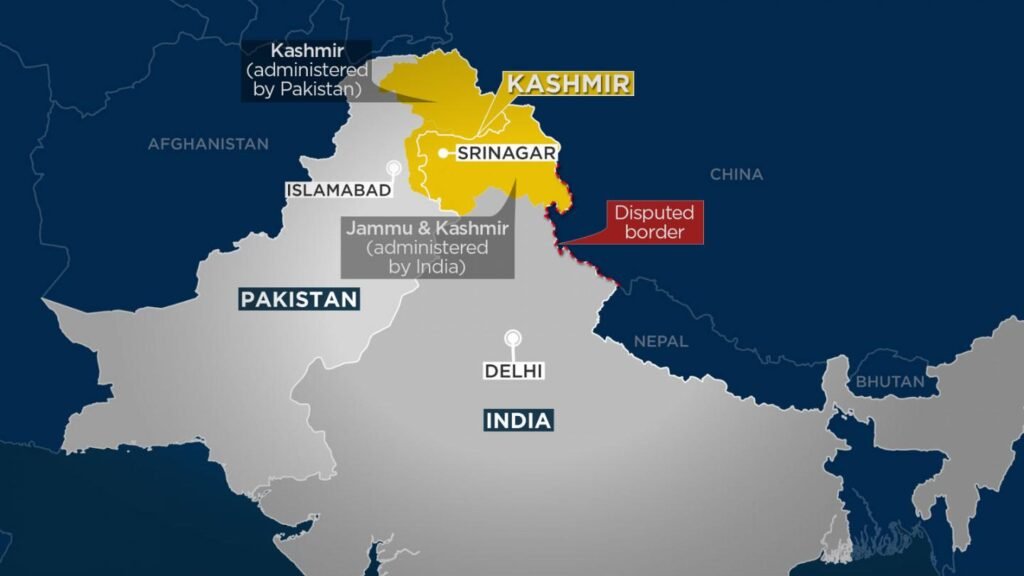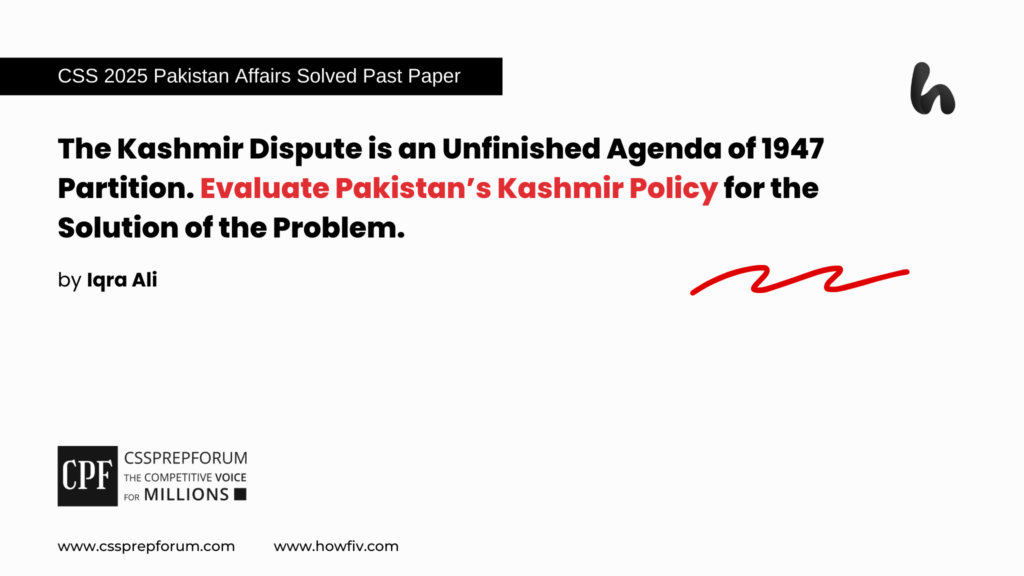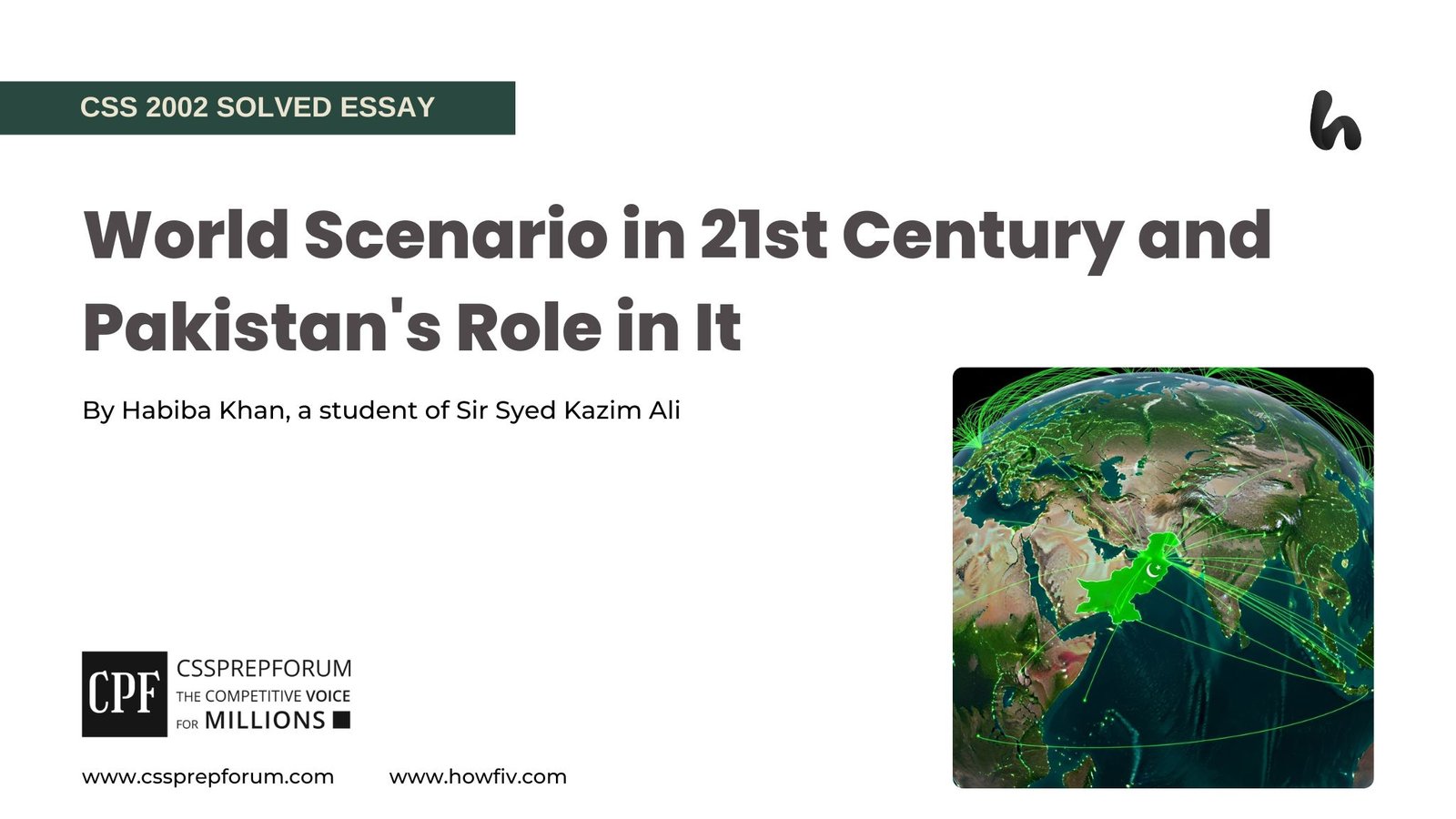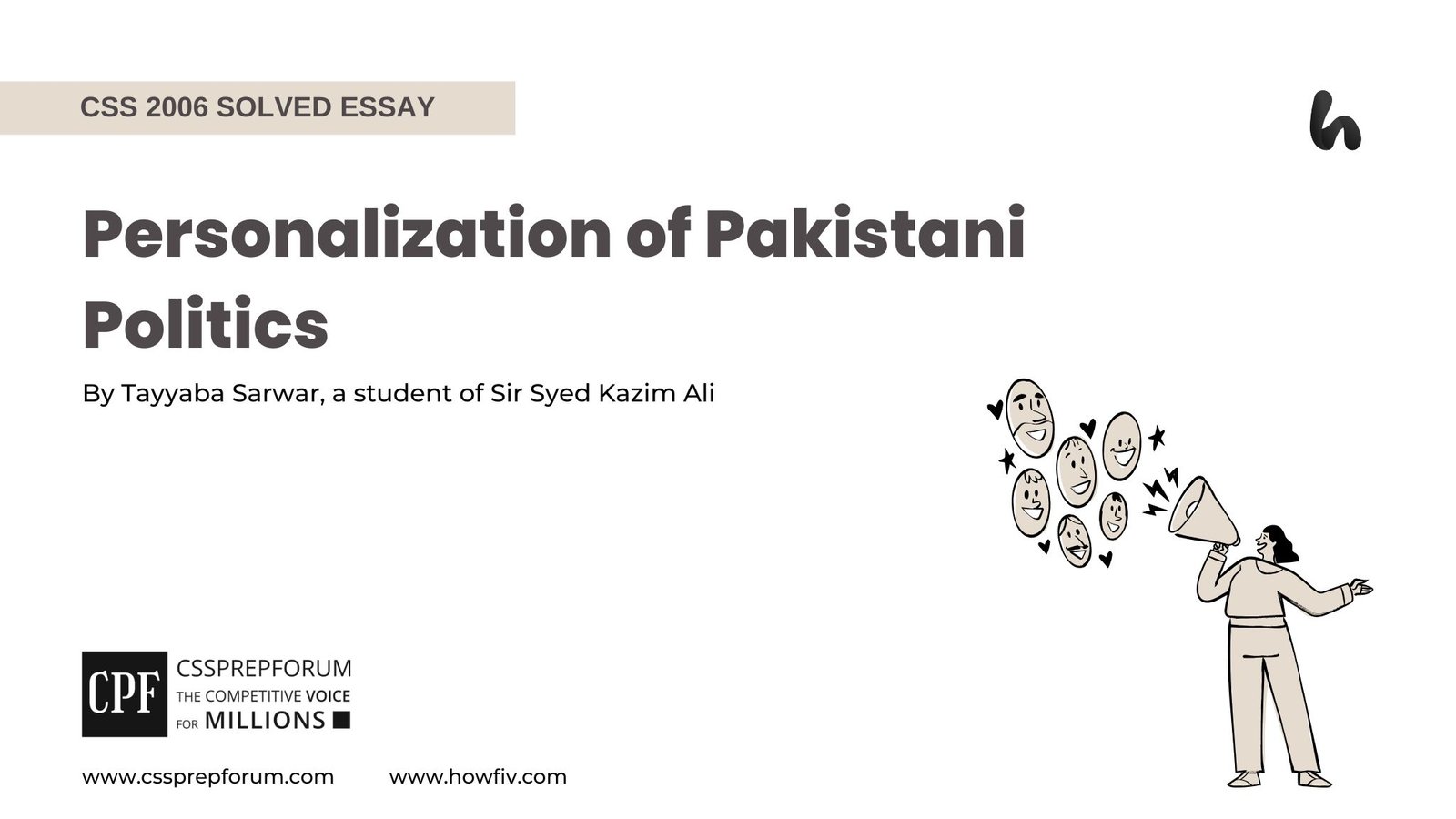CSS 2025 Solved Pakistan Affairs Past Papers | Pakistan’s Kashmir Policy for the Solution of Kashmir Dispute
The following question of CSS Pakistan Affairs 2025 is solved by Miss Iqra Ali, the best Pakistan Affairs Coach, on the guided pattern of Sir Syed Kazim Ali, which he taught to his students, scoring the highest marks in compulsory subjects for years. This solved past paper question is uploaded to help aspirants understand how to crack a topic or question, how to write relevantly, what coherence is, and how to include and connect ideas, opinions, and suggestions to score the maximum.

Question Breakdown
This question necessitates analyzing Pakistan’s Kashmir policy against the ongoing unresolved Kashmir dispute that stemmed from partition in 1947. A thorough examination of Pakistan’s Kashmir policy needs to study its methods from 1947 until 2025 by analyzing military strategies diplomatic actions, and legal frameworks as well as strategic considerations. The analysis must evaluate the productivity of these policies and identify major problems while proposing possible new strategies to solve the Kashmir dispute.
Outline
1-Introduction
2-Importance of Kashmir for Pakistan
3-Kashmir Dispute: an unfinished agenda of the 1947 partition
4-Evolution of Pakistan’s policy towards Kashmir
5-Evaluation of Pakistan’s Kashmir policy for the solution of the problem
- ✓Direct Military Engagements and Supporting resistant strategies to support Kashmiris in resolving the Kashmir Problem.
- ✓Internationalization of the Kashmir problem and involvement in multiple Diplomatic engagements.
- ✓Effect of Confidence Building Measures (CBM) and Bilateral Agreements.
- ✓Impact and Consequences of Proxy Wars.
- ✓Contemporary Challenges and Future of Pakistan’s Policy towards Kashmir
6-Critical Analysis
7-Conclusion

Introduction
The Kashmir dispute is one of the most controversial and oldest conflicts in South Asia that emerged from the partition of British India in 1947. In terms of a Muslim-majority region, Jammu and Kashmir were viewed almost as a matter of activism to join Pakistan within the tenets of partition. Nevertheless, its accession to India by Maharaja Hari Singh, when his province was invaded by tribal troops and the Indian military intervened, caused the first Indo-Pak war (1947–48). This gave rise to the conflict, which resulted in the setting up of Azad Jammu and Kashmir (AJK) under Pakistani control while India kept Jammu, Kashmir and Ladakh. Kashmir is of great importance to Pakistan for fundamental, financial and strategic reasons. Pakistan’s Muslim population fits perfectly with the core ideology of Kashmir, and its agriculture and economy are heavily dependent on the region’s water resources, which also directly impact the country. Throughout the decades, Pakistan’s Kashmir policy has gone through changes from military engagement to diplomatic and legal approaches. All these attempts, from direct conflict in 1947, 1965, and 1999, as well as in the Simla Accord (1972) to the international lobbying efforts, have been in vain; Pakistan has always looked forward to a resolution. The recent revocation of Article 370 (2019) in India has further intensified the issue, and Pakistan has responded with aggressive diplomatic, legal and narrative-building strategies. This analysis traces Pakistan’s policy over time, assessing successes and failures in this unfinished 1947 partition agenda in seeking its just resolution.
Importance of Kashmir for Pakistan
With very important strategic, economic, ideological and geopolitical significance for Pakistan, Kashmir ranks as the most critical issue on its national security and foreign policy agenda. Quaid-e-Azam Muhammad Ali Jinnah once described the region as Pakistan’s jugular vein, an apt term due to the crucial role that the region plays in the country’s very existence. Kashmir is a vital buffer zone between Pakistan, India and China. In particular, control over the region is essential in shaping regional stability and defence postures, as it lies near Pakistan’s northern frontiers and the China-Pakistan Economic Corridor (CPEC). The security repercussions of the dispute are evident from the Kargil conflict (1999) and continuous border skirmishes. Additionally, water resources from Kashmir are crucial for Pakistan’s agriculture and industry. Many scholars, like Alastair Lamb in “Kashmir: A Disputed Legacy” (1991), claimed that the accession of Kashmir to India was a political move rather than a democratic choice. Additionally, the revocation of Article 370 (2019) and the oppression of Kashmiris under Indian rule further inflames Pakistan’s stance on self-determination. The cause of Kashmir is deeply embedded within Pakistan’s geopolitical and ideological identity. ‘Pakistan is incomplete without Kashmir’; has once been quoted by a Kashmiri leader, Chaudhry Ghulam Abbas. The unresolved dispute still drives Pakistan’s foreign policy, security concerns and regional diplomacy.

Kashmir Dispute: an unfinished agenda of 1947 partition.
The fate of the Kashmir dispute was not settled on the basis of principles of partition, and hence, this has remained as an unfinished agenda of the 1947 partition. The controversial accession of Maharaja Hari Singh to India under the pressure of the Indian military sparked the First Indo-Pak War (1947–48) at the time of Independence. Yet the United Nations Security Council (UNSC) Resolutions 47 (1948), 91 (1951) and 122 (1957) also demanded a plebiscite under UN supervision, which India denied. Kashmir’s accession was acknowledged as temporary even by Indian leaders, such as Jawaharlal Nehru, who, in a speech in 1947, said, “The future of Kashmir must, however, be decided ultimately by the people of Kashmir.” The issue has become even more complicated by subsequent events such as the Second Indo-Pak War (1965), the Kargil Conflict (1999) and India’s unilateral revocation of Article 370 (2019). However, the Simla Agreement (1972) aimed to arrive at a bilateral resolution but failed as India adopted a stiff stand. Human rights organizations such as Amnesty International and Human Rights Watch have also reported mass killings, enforced disappearances and civilian suppression in IOK. As Stanley Wolpert writes more of the opposite in “India and Pakistan: Stilted Conflict,” Kashmir remains the most exigent troubling line in South Asia. Even 75 years later the case remains unresolved, threatening to poison regional stability and is a lingering consequence of the partition that cannot be ignored.
Evolution of Pakistan’s policy towards Kashmir
The following table summarizes Pakistan’s Kashmir policy throughout the years with its corresponding choices in military, diplomatic and proxy strategies ,which have their own success and failure.
| Government of Pakistan | Kashmir Policy | Success and Criticism |
| An attempted military resolution through Operation Gibraltar (1965) in order to start a local uprising in Kashmir. Indo-Pak War of 1965 followed. | Military intervention (tribal invasion) to secure the Muslim areas in Kashmir. Azad Jammu & Kashmir (AJK) and Gilgit-Baltistan came under Pakistani control. | It led to the first Indo-Pak war (1947– 48). With the UNSC’s brokered ceasefire, Resolution 47 (1948) was passed, requiring a plebiscite. It was criticised for not securing full Kashmir. |
| Multiple Governments (1951-58) | Attempts at the UN to lobby for a plebiscite. Strengthened ties with the US and Western allies. | The plebiscite was refused by India. They failed to get strong international backing. |
| Ayub Khan (1958-69) | India retaliated with full-scale war and failed. Reached Tashkent Agreement (1966) and no prolonged benefits for Pakistan. Criticized for miscalculating India’s response. | After the 1971 war, India also strengthened its position. It was the Simla Agreement that weakened Pakistan’s legal status at the UN. Criticised for helping to give diplomatic leverage to India. |
| Zulfiqar Ali Bhutto (1971-77) | Kashmir issue shifted to a bilateral framework by taking it to the Simla Agreement (1972) and reducing the UN involvement. Focused on diplomatic efforts post-1971 war. | After 1971 war, India had also strengthened its position. It was the Simla Agreement that weakened Pakistan’s legal status at the UN. Criticised for helping to give diplomatic leverage to India. |
| Zia-ul-Haq (1977-88) | Oblivious to proxy warfare and support of Kashmiri militant groups. Encouraged jihadist movements post-Soviet-Afghan War. | Increased resistance in Kashmir (1989 insurgency). India responded with military crackdowns. Criticized for promoting extremism. |
| Benazir Bhutto & Nawaz Sharif. (1988-99) | Continued diplomatic efforts. Thus, during Nawaz’s tenure, Kargil Conflict (1999) came about to militarily pressurize India in Kashmir. | However, when Kargil backfired, the country was isolated internationally. But the US got to Pakistan to withdraw under its pressure. Criticized for poor strategic planning. |
| Parvez Musharraf (1999-2008) | In terms of four Point Formula for Kashmir, it incorporates Demilitarization, Self-governance, Soft borders and Joint supervision. Backchannel diplomacy with India. | It brought India and Pakistan close to resolution (2004–2007). Lost momentum after Musharraf’s fall. Hounded for being too lenient on India. |
| PMLN & PPP Government (2008-2018) | Diplomatic engagement and Trade cross-border travel initiated focusing on confidence-building measures (CBMs). | Strong diplomatic push post-Article 370 abrogation (2019). At the UN, OIC and other global forums raised the issue of Kashmir. Cut trade ties with India. |
| Imran Khan (2018-2022) | Strong diplomatic push post-Article 370 abrogation (2019). At UN, OIC and other global forums, raised issue of Kashmir. Cut trade ties with India. | Kashmir got International attention. Lacked concrete action apart from diplomatic protests that were criticized. |
| Shehbaz Sharif (2022-till date) | Diplomatic engagement but with efforts to try and hold off on the backchannel talks. An emphasis on economic stability above all, thus aspiring to avoid escalation of the conflict. | Diplomatic pressure on India continues to no major breakthrough – mixed success. Lack of proactive measures criticized. |
Evaluation of Pakistan’s Kashmir policy for the solution of the problem.
Pakistan’s policy of Kashmir from 1947 to 2025 can be gauged by reviewing its military plans, diplomatic manoeuvres, bilateral treaties, and use of proxy forces, as well as its present problems. Military interventions and even wars (1947–48, 1965, Kargil 1999) can be evaluated with respect to the territorial gains and strategic outcome. Pakistan’s efforts at the UN, OIC and other forums at the global level have to be looked into diplomatically to find out if they’ve been able to put pressure on India or bring the international pressure to bear. Simla Agreement (1972) and Lahore Declaration (1999) have helped Pakistan deal with India directly but undermined the legal power of this country at the UN. The 1990s role of proxy warfare in highlighting the Kashmiri resistance also led to international ‘cross border terrorism’ allegations. The post-2019 developments, in particular the revocation of Article 370 by India, pose new challenges and ought to be evaluated in the context of Pakistan’s present policy approach and future strategic direction.
- ✓Direct Military Engagements and Supporting resistant strategies to support Kashmiris in resolving the Kashmir Problem.
Pakistan’s approach to the Kashmir conflict has been via war, warfare and support for the insurgency movement. Kashmir was divided in terms of the First Indo-Pak War (1947–48) and these territories were secured by Pakistan in Azad Jammu and Kashmir (AJK) and Gilgit-Baltistan. In spite of that, Pakistan was unable to achieve full control over the territory due to the ceasefire and UNSC Resolution 47 (1948). The Indian involvement in the Second Indo-Pak War (1965) by committing Operation Gibraltar to initiate an uprising in Indian-occupied Kashmir, and ultimately having a stalemate in the form of the Tashkent Agreement (1966), which rolled back to the status as it was before the war. The Kargil conflict that followed in 1999 was precipitated by Pakistan’s military and had temporarily gained strategic heights but was globally condemned, forcing Pakistan’s withdrawal. In the 1980s and 1990s, Pakistan supported Kashmiri insurgents to further increase resistance against the rule of India. However, post 9/11, it backfired when India labelled Kashmiri militants as terrorists and got the full backing of the world. Military intervention sustained the Kashmir issue, and while they failed to gain a clear-cut victory, they sometimes got diplomatic setbacks. Christine Fair (Fighting to the end: Pakistan army’s way of war) maintains that it has weakened Pakistan’s international standing instead of solidifying Pakistan’s Kashmir claim.
- ✓Internationalization of the Kashmir problem and involvement in multiple Diplomatic engagements.
In the realm of diplomacy, Pakistan has been a firm believer in internationalizing the issue and securing the support of the international community. Significant milestones were reached with an early focus on UN intervention, such as UNSC Resolution 47 (1948), which urged for a plebiscite to determine the fate of Kashmir. However, the diplomatic strategy adopted by Pakistan did not bear fruit due to India’s refusal to allow the plebiscite and, subsequently, India’s rejection of the resolution itself. But Pakistan kept insisting on international participation in the Kashmir dispute on several forums, including the UN General Assembly (UNGA) and the Organization of Islamic Cooperation (OIC). Pakistan intensified its diplomatic lobbying in the 1970s and 1980s and sought international mediation through organizations like the OIC. Despite UN Resolution 91 (1951); renewed affirmation of the right to a plebiscite, the changing global geopolitics and Pakistan’s isolation often left tangible outcomes in the realm of the abstract. The Lahore Declaration (1999) was a key moment when both countries agreed on peace, though it went ashore in the Kargil conflict. In the aftermath of India’s revocation of Article 370 in 2019, Pakistan has been successful at pulling the UNGA into its orbit, something Prime Minister Imran Khan’s 2019 speech on Kashmir’s humanitarian crisis did to get the world’s attention. India’s growing foreign policy clout, particularly in its engagements with the US and other major powers, has worked against the success of Pakistan’s diplomatic push. As India is stronger on the diplomatic front compared to Pakistan, it is crucial for the latter to win global support to counter it.
- ✓Effect of Confidence Building Measures (CBM) and Bilateral Agreements.
Pakistan’s Kashmir policy has been moulded under the auspices of bilateral agreements and Confidence Building Measures (CBMs). After the 1971 Indo-Pak war, it was marked with a change in relations through the Simla Agreement (1972). The two countries decided to settle the Kashmir dispute bilaterally, ignoring international mediation. But promises of peaceful dialogue fell by the wayside, except that there has been no real progress on Kashmir and India persistently sticking to its constitutional claims to the area. According to Agha Shahi in his memoir ‘The Man Who Would Be Prime Minister’, the Simla Agreement generally paved the way for peace, but without a clear resolution on Kashmir’s status. Another landmark was the Lahore Declaration (1999) to reduce tensions and promote dialogue. But that was derailed by the Kargil conflict, which showed how brittle these agreements were without actual progress on Kashmir. After 2000, however, CBMs like cross-border trade and the opening of Kashmir routes for communication thawed out the relations a bit, and there were more people-to-people exchanges. However, these measures were unstable and did not produce a lasting peace process. As C. Christine Fair argues in Fighting to the End: The Pakistan Army’s Way of War, these CBMs were largely cosmetic and did not deal with the essential question of the political status of Kashmir, making them ineffectual in securing peace on a long-term basis.
- ✓Impact and Consequences of Proxy Wars.
Unarguably, the most important component of Pakistan’s Kashmir policy in the last two decades has been its use of proxy warfare in Kashmir, especially in the 80s and 90s. Following the Indian occupation of Kashmir internationally and the inability to achieve military success, Pakistan encouraged insurgents in Kashmir as a means to apply pressure on India. Through funding, training and offering logistical support to Kashmiri militants, Pakistan had backed the insurgency. In particular these efforts were particularly pronounced during the 1989 insurgency, when Kashmiri militant groups, with alleged Pakistan support, had attacked Indian forces, causing heavy casualties. The 1990s insurgency was a historic turning point for Pakistan as it took the Kashmir issue to the international level in such a way that a proxy group could provide plausible deniability for Pakistan. But it also had major drawbacks. India and the international community, notably after the 1993 Mumbai Bombings and the 2001 Indian Parliament attack, accused Pakistan of being behind terrorism internationally. It tarnished Pakistan’s diplomatic standing and caused sanctions and international isolation. To top it all, the rise of global terrorism following 9/11 put the country in the thick of it and excessively impacted its diplomacy through compromised relations with the West; Pakistan’s relationship with terror organisations like Lashkar e Taiba was also a complicating factor. However, the positive side was that proxy warfare raised global awareness about the Kashmir issue, which was put on paper, particularly during the 1999 Kargil War in which Pakistan focused the world on the militarized plight of the given region. But the short-term benefits have paled in comparison to the long-term costs of maintaining increased visibility — international sanctions and loss of moral authority in global forums.
- ✓Contemporary Challenges and Future of Pakistan’s Policy towards Kashmir
Pakistan’s Policy for Kashmir in the contemporary geopolitics has several challenges. One of the biggest challenges is India’s revocation of Article 370 in 2019, taking away special status from Jammu and Kashmir and bringing the region even closer to India’s own political framework. This effectively transformed the territorial dispute into an internal issue for India, increasing the difficulty for Pakistan to gain international support. As Ayesha Siddiqa also notes in her book Military Inc., Pakistan’s reaction to this change has been predominantly diplomatic, but efforts to curb India’s actions at the UN and OIC have not been very productive. Another issue is that of diplomatic isolation from Pakistan, as India has had better relations with world powers, notably the United States, through the strategic partnerships of Quad. This geopolitical shift has weakened Pakistan’s diplomatic leverage and its standing in the global forum. Further, allegations of terrorism across borders keep Pakistan from enjoying an international image as India is portraying it as a state sponsor of this terrorism. Pakistan also needs to move from a reactive to a proactive policy in terms of regional alliances and in promoting the Kashmir issue in a human rights framework, as evident in its efforts to raise India’s post-2019 actions on Kashmir awareness. But if it can negotiate with China, Russia, and regional allies it may be able to regain international focus on Kashmir and develop new diplomatic avenues to resolve the conflict, all while implementing strategy and sustained international advocacy.
Critical Analysis
The Kashmir dispute, itself a permanent thorn in India and Pakistan’s necks, has played an integral part in shaping the geopolitical fabric of the South Asian region ever since India attained independence in 1947. According to critics, Pakistan’s Kashmir policy has in the past been reactive, responding to short-term situations instead of drawing up long-term plans. Pakistan’s diplomatic thrust appears commendable since 2019 but the ground is somewhat grueling on account of India’s entrenched position. Pakistan must advance an overall and multifaceted approach, which includes regional cooperation and human rights advocacy, to make advances on the issue in the international realm. It must strike a balance of diplomatic and military tools but cannot go overboard in relying on external proxies, which has proved counterproductive in the past.
Conclusion
The Kashmir dispute, the most complicated and enduring problem of international relations, has strong historical, political and emotional ties between Pakistan and India. For decades, Pakistan’s Kashmir policy has faced twists and turns, ranging from military strategies and diplomatic efforts to proxy engagements. Although some policies have, in the short run, resulted in gains, the long-term success of these policies has not been possible because of Indian strategic responses and the changing global geopolitical landscape. Future prospects for a peaceful resolution depend on developing a more coherent, more proactive strategy in which Pakistan resolves to build upon sustainable dialogue, enhanced regional cooperation and utilizing international institutions. The road to a resolution is difficult but there is still a possibility for a diplomatic breakthrough but it will need a fine line between assertive advocacy and practical negotiation that will maintain the Kashmir issue at the global forum.

CSS 2025 Solved Pakistan Affairs
| 2- | How did the Indus Waters Treaty (1960) affect water distribution and relations between Pakistan and India? |
| 3- | Examine the causes and consequences of the 1971’separation of East Pakistan, highlighting the role of regional and international players. |
| 4- | Explore the significance of CPEC (China-Pakistan Economic Corridor) for the economic development of Pakistan. What are its (potential challenges and opportunities? |
| 5- | Analyze the demographic and cultural diversity of Pakistan and its impact on national integration and policymaking. |
| 6- | Critically evaluate the impact of Bhutto’s nationalization policy on the economy of Pakistan. |
| 7- | The Kashmir dispute is an unfinished agenda of the 1947 partition. Evaluate Pakistan’s Kashmir policy for the solution of the problem. |
| 8- | Is media a curse or blessing? Critically evaluate its role in shaping public opinion and influencing political events in Pakistan in the 21st century. |
CSS Solved Past Papers’ Essays
Looking for the last ten years of CSS and PMS Solved Essays and want to know how Sir Kazim’s students write and score the highest marks in the essays’ papers? Then, click on the CSS Solved Essays to start reading them.
CSS Solved Essays
CSS Solved General Science & Ability Past Papers
Want to read the last ten years’ General Science & Ability Solved Past Papers to learn how to attempt them and to score high? Let’s click on the link below to read them all freely. All past papers have been solved by Pakistan’s top CSS GSA coach having the highest score of their students.
General Science & Ability Solved Past Papers












